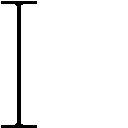Hello,
I am looking for some guidance to recognize parts, I-beams in particular. What I would like to achieve is to recognize it's an I-beam and to determine its dimensions like height, width, radius and thickness (flange and web)
I can make use of the fact that the parts always should have concave fillets (radii) along the direction of the profile.
What I have tried so far. It looked the easiest to first make it a 2D problem instead of a 3D problem.
- Use the direction of the cylindrical surface with the longest length as a projection direction and then project with
- Use
Any suggestions on how to deal with this? Should I look into feature recognition with the help of an aag? The below pictures are just an example.
Thanks,
Dirk


I am looking for some guidance to recognize parts, I-beams in particular. What I would like to achieve is to recognize it's an I-beam and to determine its dimensions like height, width, radius and thickness (flange and web)
I can make use of the fact that the parts always should have concave fillets (radii) along the direction of the profile.
What I have tried so far. It looked the easiest to first make it a 2D problem instead of a 3D problem.
- Use the direction of the cylindrical surface with the longest length as a projection direction and then project with
HLRAlgo_Projector and then try to make a wire from the projected edges. I could not make this work reliably as it is hard to determine which edges need to be part of the wire. Also, the projected cylindrical surfaces could result in edges of type b-spline instead of circles.- Use
BOPAlgo_Section to generate a section with as a tool a face defined by a plane with the direction of the profile. The resulting edges are easily converted to a wire and the edges could still be analytical. The problem with this approach is where to do the section. The beam could have holes in it which messes up the section result if the section plane intersects with a hole.Any suggestions on how to deal with this? Should I look into feature recognition with the help of an aag? The below pictures are just an example.
Thanks,
Dirk




